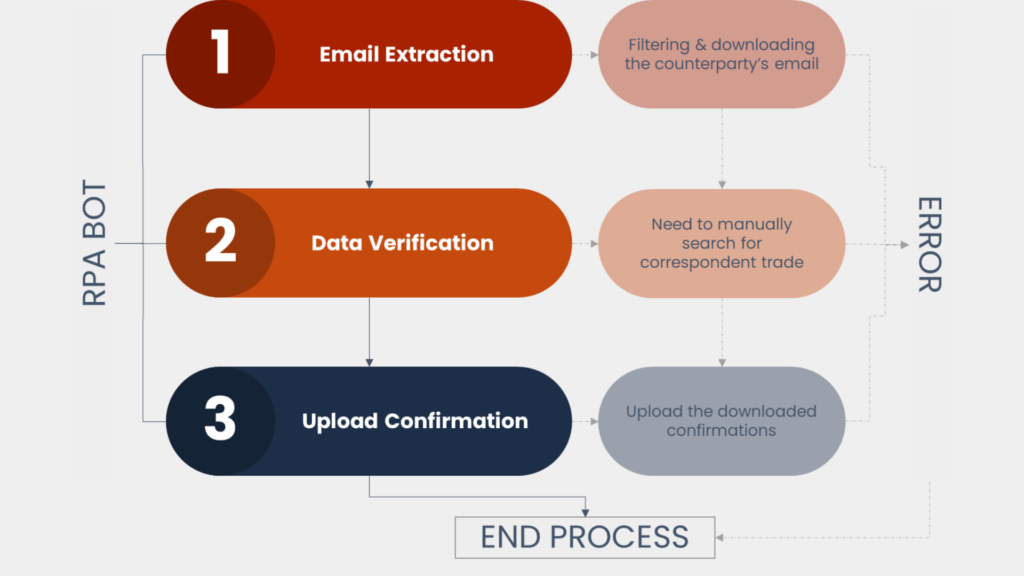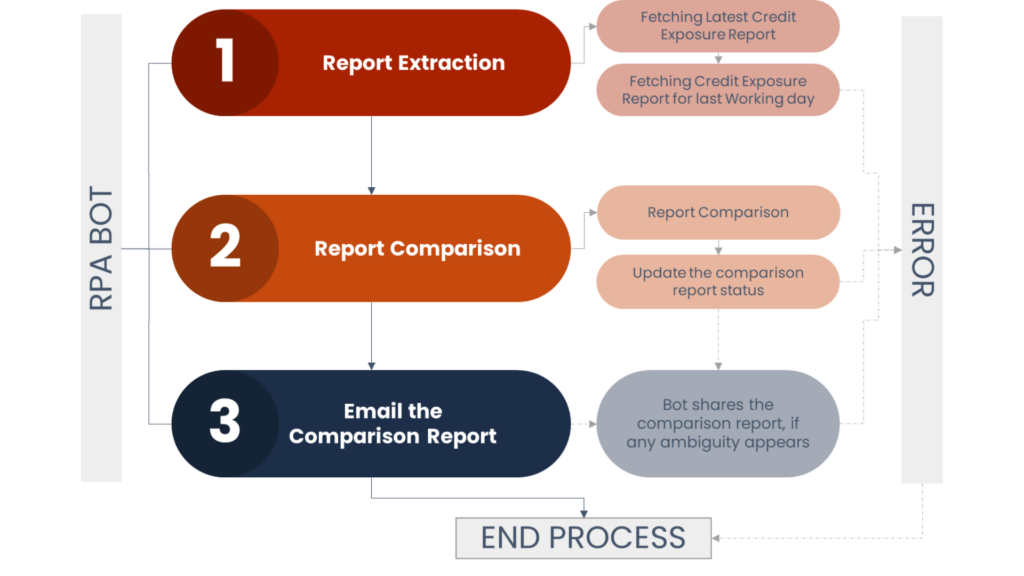Enhancing Efficiency and Risk Management
RPA technology in ETRM systems enables organizations to optimize processes, reduce manual intervention, improve data accuracy, ensure regulatory compliance, and enhance risk management capabilities. It empowers your in-house resources to focus on more strategic and value-added activities, leading to increased operational efficiency and better decision-making.
In this blog we highlight how RPA can be leveraged within Allegro for two critically manual processes; Counterparty Confirm Uploads and Day Credit Exposure Changes.
Counterparty Confirm Uploads
The counterparty confirm upload is crucial for accurate data, risk management, trade settlement, compliance, and reporting. Challenges like data compatibility, integration complexity, and manual intervention can be addressed using RPA, enhancing efficiency and compliance in confirm uploads while improving operational effectiveness.
The current process is highly manual and requires users to follow a 4-step process for each confirmation upload.
There are several benefits of the RPA technology used to address the concerns around Counterparty Confirm Upload:
RPA bots excel in executing tasks with unparalleled accuracy, eradicating the possibility of human errors in data entry, validation, and processing. This leads to a substantial decrease in discrepancies, minimizes the requirement for manual intervention, and guarantees dependable confirmations.
RPA bots operate tirelessly 24/7/365. They possess the capability to swiftly handle substantial volumes of confirmations, allowing organizations to accelerate their entire workflow. Through the automation of mundane tasks, employees are liberated to concentrate on more strategic and value-added activities.

Implementing RPA for automating counterparty confirm uploads can lead to significant cost savings. Through the reduction of manual labor and the mitigating of associated errors, organizations can streamline their operations, optimize the allocation of resources, and decrease operational costs.

RPA can be configured to adhere to stringent compliance regulations and standards, guaranteeing that all confirmations align with regulatory requirements and internal policies. This proactive approach reduces the risk of non-compliance and potential penalties.
Day Credit Exposure Changes
Accurate mapping, testing, and validation are crucial to ensure proper calculation and reflection of Day Credit Exposure Changes. Several challenges such as data mapping, differences in functionality, integration with third-party systems, testing, and user training also hamper the risk assessments. Diligent planning and execution are vital for overcoming these challenges hence, automating this step not only saves time but also aids in accurate credit exposure calculations, reporting, and analytics.
The current process is highly manual and requires users to follow a 5-step process for each day credit and exposure change.
There are several benefits of the RPA technology used to address the concerns when dealing with credit exposure changes:
RPA facilitates the integration of data from diverse sources, including internal systems, external databases, and financial statements. This integration streamlines data-gathering processes, automates them, and guarantees the availability of accurate and current information for credit exposure calculations.
RPA bots can perform tasks at a much faster pace compared to manual efforts. They can retrieve credit data from multiple sources, analyze it, and update the system in real time. It can also handle high volumes of credit exposure changes efficiently, allowing for scalability as the business expands.
RPA technology provides greater control and reduces the risk of credit exposure errors. It enforces standardized processes and ensures compliance with credit policies and regulations. By automating credit exposure change workflows, RPA minimizes the risk of unauthorized changes or fraudulent activities.
RPA bots can generate personalized reports and dashboards that offer valuable insights into the evolution of credit exposure over time. These reports empower stakeholders to make informed decisions and identify emerging trends or risks, facilitating proactive measures to mitigate potential challenges.
Challenges and Considerations for RPA Implementation in Allegro
While RPA technology provides numerous benefits for automating processes in Allegro, there are also some challenges and considerations to keep in mind. Here are a few:
Process Complexity
Data Quality and Variability
Maintenance and Monitoring
Overall, while RPA offers significant benefits for automating Allegro processes, careful attention should be paid to process complexity, data quality, maintenance, and many other factors to overcome challenges and ensure successful implementation.
Utilize Value Creed’s RPA Expertise
Value Creed’s robotic process automation services eliminate data flow bottlenecks and minimize the need for human intervention in performing routine and repetitive tasks. This advanced technology streamlines business processes, mitigates the risk of data corruption, and maintains data integrity. Moreover, RPA integration with ETRM systems automates critical and time-consuming tasks mentioned earlier, enabling improved analytics and reporting capabilities.
Get in touch with us today to discover more about our robotic process automation services. Benefit from our expertise in automating your system processes and unlock the potential for increased efficiency and productivity.
Ready to Put Robotic Process Automation to Work?
Let’s Talk





